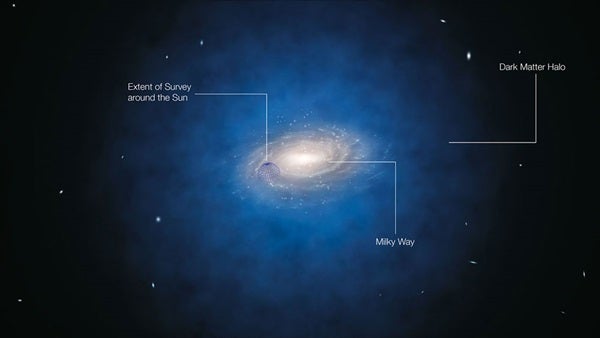A team using the MPG/ESO 2.2-meter telescope at the European Southern Observatory’s (ESO) La Silla Observatory, along with other telescopes, has mapped the motions of more than 400 stars up to 13,000 light-years from the Sun. From this new data, they have calculated the mass of material in the vicinity of the Sun, in a volume four times larger than ever considered before.
“The amount of mass that we derive matches very well with what we see — stars, dust, and gas — in the region around the Sun,” said Christian Moni Bidin from the University of Concepcion in Chile. “But this leaves no room for the extra material — dark matter — that we were expecting. Our calculations show that it should have shown up very clearly in our measurements. But it was just not there!”
Dark matter is a mysterious substance that cannot be seen but instead shows itself by its gravitational attraction for the material around it. This extra ingredient in the cosmos was originally suggested to explain why the outer parts of galaxies, including the Milky Way, rotated so quickly, but dark matter now also forms an essential component of theories of how galaxies formed and evolved.
Today, it is widely accepted that this dark component constitutes about 80 percent of the mass in the universe, despite the fact that it has resisted all attempts to clarify its nature, which remains obscure. All attempts so far to detect dark matter in laboratories on Earth have failed.
By very carefully measuring the motions of many stars, particularly those away from the plane of the Milky Way, the team could work backward to deduce how much matter is present. The motions are a result of the mutual gravitational attraction of all the material, whether normal matter such as stars, or dark matter.
Astronomers’ existing models of how galaxies form and rotate suggest that the Milky Way is surrounded by a halo of dark matter. They are not able to precisely predict what shape this halo takes, but they do expect to find significant amounts in the region around the Sun. But only unlikely shapes for the dark matter halo — such as a highly elongated form — can explain the lack of dark matter uncovered in the new study.
The new results also mean that attempts to detect dark matter on Earth by trying to spot the rare interactions between dark matter particles and “normal” matter are unlikely to be successful.
“Despite the new results, the Milky Way certainly rotates much faster than the visible matter alone can account for,” said Moni Biden. “So, if dark matter is not present where we expected it, a new solution for the missing mass problem must be found. Our results contradict the currently accepted models. The mystery of dark matter has just become even more mysterious. Future surveys, such as the European Space Agency’s Gaia mission, will be crucial to move beyond this point.”










